Physical Address
304 North Cardinal St.
Dorchester Center, MA 02124
Diagnosis
Normal IOP: mean IOP in the general population is 16 mm Hg; two standard deviations to either side of this gives a ‘normal’ IOP range of 11–21 mm Hg ( Fig. 10.1 ).
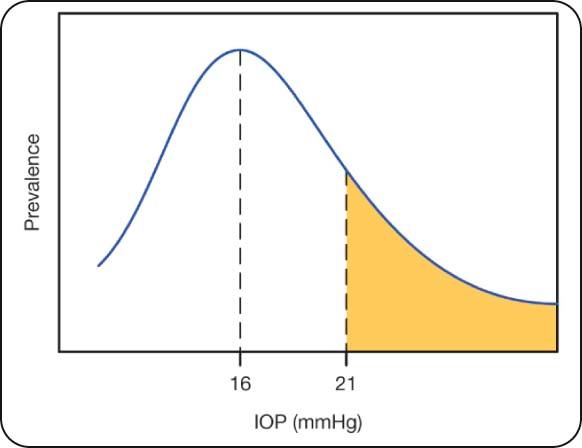
Definition: 4–7% of individuals older than 40 years have IOPs >21 mm Hg without detectable glaucomatous damage—‘ocular hypertension’ (OHT).
Risk factors for conversion of OHT to glaucoma: (a) higher IOP, (b) greater age, (c) lower central corneal thickness, (d) larger C/D ratio, and (e) higher ‘pattern standard deviation’ on perimetry.
Management
Drug choice: as for primary open-angle glaucoma (POAG; see below), although regimen may be less aggressive.
Risk of conversion to POAG: after 5 years if untreated is 9.5%, and 4.4% if treated.
Other considerations: (a) individual patient profile (e.g. age/life expectancy, patient preference, and risk factors); (b) consider treating every patient with an IOP of ≥30 mm Hg.
Introduction
Definition: POAG is a generally bilateral disease of adult onset characterized by (a) IOP >21 mm Hg at some stage, (b) glaucomatous optic neuropathy, (c) open angle, (d) characteristic visual field loss as damage progresses, and (e) absence of signs of secondary glaucoma.
Risk factors: (a) elevated IOP, (b) greater age, (c) race (more common in black than white individuals), (d) family history (first-degree relatives) of POAG, (e) myopia, and (f) systemic vascular disease; elevation of IOP in response to topical steroid is more common in POAG than the general population.
Diagnosis
History: usually asymptomatic until damage is advanced; (a) past ophthalmic history including refractive status, (b) family history, and (c) past medical history and current medication.
General examination: (a) pupils, (b) slit lamp, (c) tonometry, (d) pachymetry for central corneal thickness (CCT), (e) gonioscopy, and (f) optic disc examination with dilated pupils.
Perimetry : visual field defects include (a) small paracentral depression (70% of early defects), (b) arcuate-shaped defect, (c) nasal step, (d) ring scotoma, and (e) end-stage changes with a small residual island of central vision.
Imaging: of discs and peripapillary retinal nerve fibre layer (see below).
Optic disc changes
Diffuse enlargement of the cup ( Fig. 10.2a ).
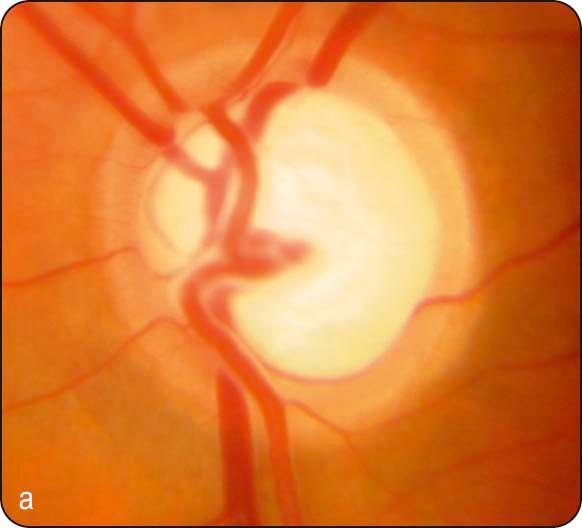
Focal notching, often inferior, of the neuroretinal rim (NRR) ( Fig. 10.2b ).
C/D ratio asymmetry may develop; comparison of overall disc diameter is critical.
Retinal nerve fibre layer defects.
Loss of nasal NRR.
‘Sharpened’ disc edge as adjacent NRR is lost.
Lamina dot sign (exposed grey dot-like fenestrations in the lamina cribrosa; Fig. 10.2c ).
Vascular changes: (a) ‘splinter’ disc haemorrhages, (b) baring of circumlinear blood vessels (space between a superficial vessel and the disc margin), (c) bayoneting (double angulation of a vessel as it bends backwards due to loss of underling NRR), and (d) collateral disc vessels. Progression of peripapillary atrophy, particularly the inner (beta) zone ( Fig. 10.2d ).
Imaging modalities: (a) stereo disc photography, (b) confocal scanning laser tomography (e.g. Heidelberg retinal tomograph), (c) scanning laser polarimetry (e.g. GDx glaucoma diagnosis), and (d) optical coherence tomography (OCT).
Management: lowering IOP is the only proven method of slowing progression. A target IOP should be set, with subsequent monitoring and target resetting if progression occurs.
Initial medical therapy: with one drug in its lowest concentration, instilled as infrequently as possible consistent with the desired effect.
Review: after 4–8 weeks, when response is assessed against target IOP, and if satisfactory subsequently after a further 3–6 months.
Causes of failure: (a) poor compliance (25% of patients), (b) inadequate instillation technique, (c) inappropriate target pressure, and (d) IOP fluctuations including wide diurnal variation.
Ongoing monitoring: optic disc assessment, perimetry (annual in most low–moderate risk cases), and annual gonioscopy (angles narrow with age).
Laser trabeculoplasty: selective laser trabeculoplasty (SLT) or argon laser trabeculoplasty (ALT) can be used to replace or supplement medical treatment; indications include (a) patient preference, (b) intolerance of medical therapy, and (c) avoidance of polypharmacy or surgery.
Indications for surgery: (a) failed medical therapy, (b) intolerance of medical therapy, (c) avoidance of polypharmacy, (d) progressive deterioration despite seemingly adequate IOP control, and (e) as primary therapy in some patients.
Trabeculectomy: is the most common procedure, although nonpenetrating surgery is also widely performed. If significant lens opacity is present, phacoemulsification alone may be associated with a fall in IOP; alternatively, it can be combined with a filtration procedure (e.g. phacotrabeculectomy).
Introduction
Definition: (a) glaucomatous optic neuropathy, (b) IOP consistently ≤21 mm Hg, and (c) open angle.
Risk factors: (a) age (older than in POAG), (b) race (particularly prevalent in Japan), (c) family history of glaucoma, (d) CCT (thinner than in POAG), (e) systemic hypotension including nocturnal blood pressure dips, and (f) possibly abnormal vasoregulation (e.g. migraine, Raynaud phenomenon).
Differential diagnosis: (a) POAG with apparently normal IOP, (b) nocturnal IOP spikes, (c) previous secondary raised IOP (trauma, uveitis, steroids, resolved pigmentary glaucoma), (d) masking of elevated IOP by systemic treatment (e.g. beta-blocker), (e) previous acute optic nerve insult (e.g. anterior ischaemic optic neuropathy), (f) hypovolaemic or septicaemic shock, (g) progressive retinal nerve fibre defects not due to glaucoma (e.g. myopic degeneration, disc drusen), (h) congenital disc anomalies (e.g. disc pits, coloboma), and (i) chiasmal or optic nerve compression.
Diagnosis
Specific points in the history: (a) migraine and Raynaud phenomenon, (b) episodes of shock, (c) headache and other neurological symptoms, and (d) systemic steroids and beta-blockers.
Specific points in the examination: (a) IOP is usually in the high teens but may be lower; (b) glaucomatous cupping is similar to POAG, although acquired optic disc pits, peripapillary atrophic changes, and disc splinter haemorrhages may be more frequent than in POAG.
Field defects : may be closer to fixation and more localized than in POAG.
Other investigations: as for POAG, but in certain patients consider assessment of systemic vascular risk factors, 24 h ambulatory blood pressure monitoring to exclude nocturnal systemic hypotension, blood tests for other causes of nonglaucomatous optic neuropathy, and cranial MR.
Treatment
Indications: visual fields are stable in 50% over 5 years without treatment, so in mild cases it may be appropriate to demonstrate progression before treating; further IOP reduction is effective in reducing progression in at least some patients.
Topical: may include betaxolol thought to increases optic nerve blood flow.
Surgery (or laser trabeculoplasty): if progression occurs despite reduced IOP.
Systemic: (a) control of systemic vascular disease, (b) calcium channel blockers to counter vasospasm, and (c) if significant nocturnal dips in BP are detected, consider reducing antihypertensive medication (especially bedtime dosing).
Introduction
Definition: ‘angle closure’ refers to occlusion of the trabecular meshwork by the peripheral iris—iridotrabecular contact (ITC), obstructing aqueous outflow. The condition is responsible for up to half of all cases of glaucoma globally and is typically associated with greater visual morbidity than POAG.
Mechanisms: (a) pupillary block—failure of aqueous flow through the pupil leading to anterior bowing of the iris ( Fig. 10.3 )—is relieved by peripheral iridotomy; (b) non pupillary block relating to a thicker or more anteriorly positioned iris ( Fig. 10.4 ), including plateau iris due to anteriorly positioned ciliary processes, is only partially relieved by iridotomy; and (c) plateau iris configuration characterized by a flat central iris plane with a normal central anterior chamber depth.

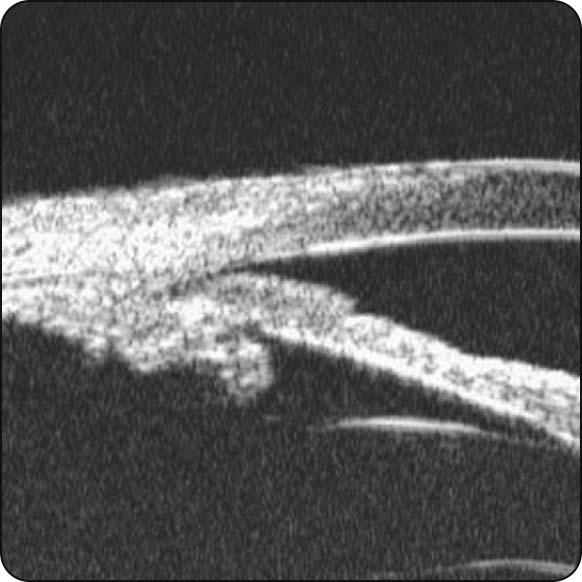
Risk factors: (a) age, (b) gender (female > male), (c) race (high Far Eastern prevalence), (d) family history, (e) hypermetropia, and (f) shorter ocular and anterior chamber dimensions.
Diagnosis
Primary angle-closure suspect (PACS): (a) gonioscopy shows ITC in three or more quadrants but no peripheral anterior synechiae (PAS), and (b) normal IOP, discs, and fields.
Primary angle closure (PAC): (a) gonioscopy shows three or more quadrants of ITC ( Fig. 10.5 ), (b) raised IOP and/or PAS, and (c) normal discs and fields.
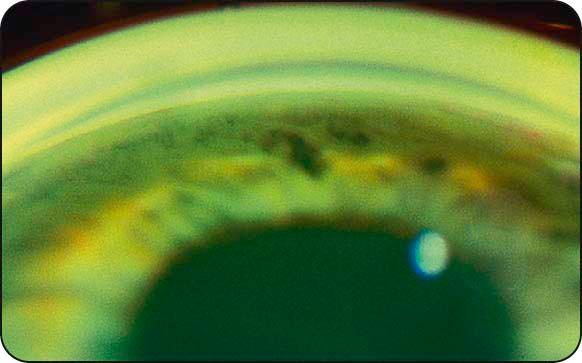
Primary angle-closure glaucoma (PACG): (a) gonioscopy shows ITC in three or more quadrants, and (b) glaucomatous optic neuropathy.
Chronic and subacute presentations: typically asymptomatic although episodic mild blurring may be present; (a) IOP elevation may be intermittent, (b) disc appearance depends on severity of damage, and (c) PAS may be broad (‘creeping’) or discrete (‘sawtooth’).
Acute presentation: acute onset of blurring and haloes, ocular pain and headache, sometimes malaise and gastrointestinal symptoms; (a) VA usually 6/60-HM, (b) IOP very high (50–100 mm Hg), (c) corneal epithelial oedema ( Fig. 10.6 ), (d) ciliary injection, (e) shallow anterior chamber ( Fig. 10.7 ), and (f) unreactive mid-dilated vertically oval pupil; fellow eye shows an occludable angle.
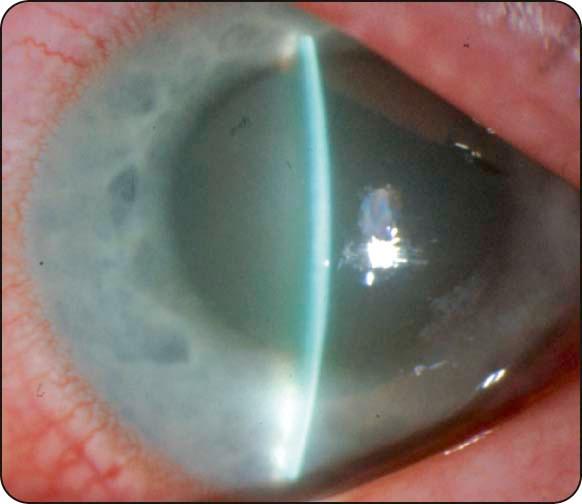
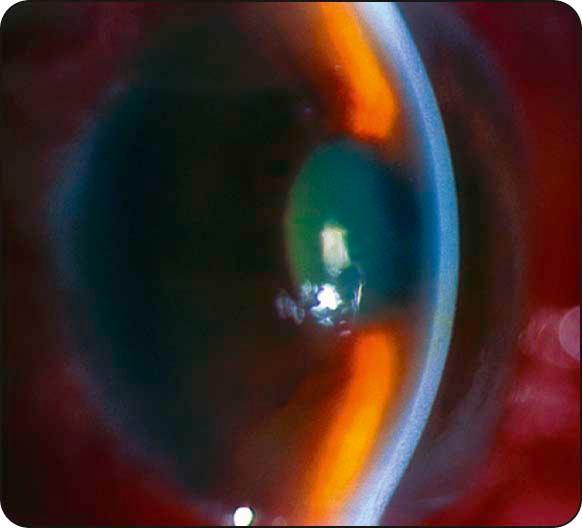
Resolved acute episode: (a) initially, folds in Descemet membrane ( Fig. 10.8 ), optic nerve head congestion, and choroidal folds; (b) later, iris atrophy with a spiral configuration, irregular pupil with posterior synechiae, glaukomflecken ( Fig. 10.9 ), and optic atrophy.
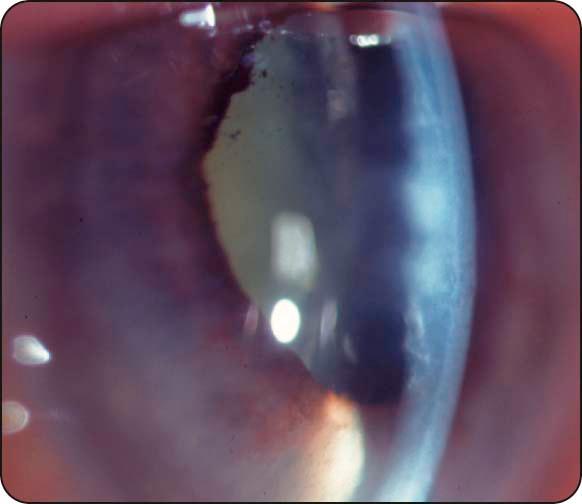
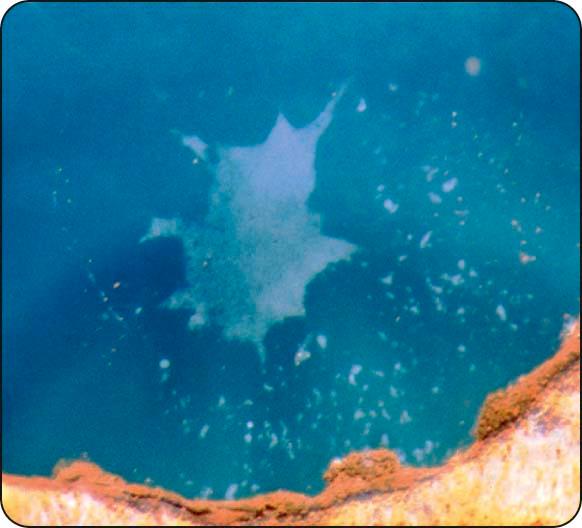
Treatment
PACS: prophylactic laser iridotomy; if significant ITC persists, options include observation, laser iridoplasty, pilocarpine 1% prophylaxis, and lens extraction.
Chronic presentation of PAC and PACG: as for PACS, although subsequent medical treatment (as for POAG) may be required despite an opened angle.
Initial treatment of acute and subacute presentation: (a) intravenous acetazolamide 500 mg, (b) topical apraclonidine 1%, timolol 0.5%, prednisolone 1%, or dexamethasone 0.1% to the affected eye, and (c) pilocarpine 2–4% one drop to the affected eye, repeated after 30 min, with one drop of 1% as prophylaxis to the fellow eye; consider delaying pilocarpine until IOP begins to fall.
Subsequent treatment of acute and subacute presentation: (a) pilocarpine 2% four times daily to the affected eye and 1% to the fellow eye, (b) ongoing treatment according to IOP with timolol 0.5% twice daily, apraclonidine 1% three times daily, and oral acetazolamide 250 mg four times daily; once cornea is clear and eye quieter, bilateral laser iridotomy is performed and medical treatment tapered.
Options in unresponsive acute cases: (a) further topical pilocarpine, timolol, and apraclonidine, (b) intravenous mannitol or oral glycerol, (c) corneal indentation, (d) laser iridotomy or iridoplasty (clear oedema with glycerol 50% first), and (e) surgery (peripheral iridectomy, lens extraction, goniosynechialysis, trabeculectomy).
Differential diagnosis of acute IOP elevation: consider alternatives to angle closure, particularly if the fellow eye's angle is open.
Lens-induced angle closure due to an intumescent or subluxated lens.
Malignant glaucoma, especially if intraocular surgery has recently taken place.
Other causes of secondary angle closure, with or without pupillary block (see below).
Neovascular glaucoma sometimes presents acutely.
Inflammatory elevation with an open angle; iridocyclitis/trabeculitis, glaucomatocyclitic crisis (Posner–Schlossman syndrome), scleritis without angle closure.
Pigment dispersion.
Pseudoexfoliation.
Orbital/retro-orbital lesions (e.g. inflammation, retrobulbar haemorrhage).
Pathogenesis: grey-white fibrillary material is produced by abnormal basement membranes of ageing intraocular epithelial cells and deposited in structures including the trabeculum; particularly common in Scandinavia.
Diagnosis
Cornea: pseudoexfoliation (PXF) material and pigment may be seen on the endothelium.
Iris: PXF on the pupillary margin ( Fig. 10.10 ) and ‘moth-eaten’ sphincter atrophy ( Fig. 10.11 ).
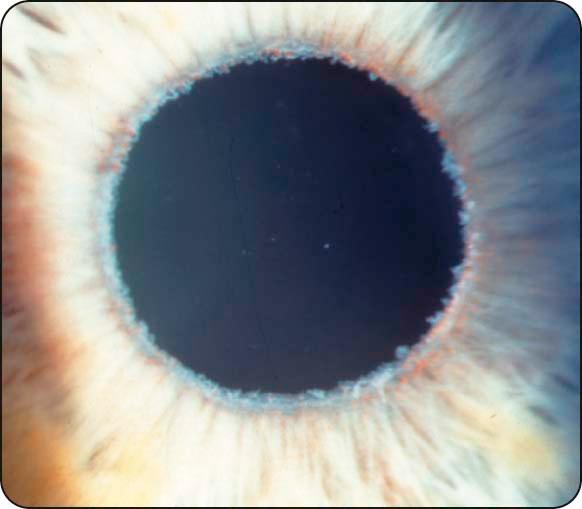
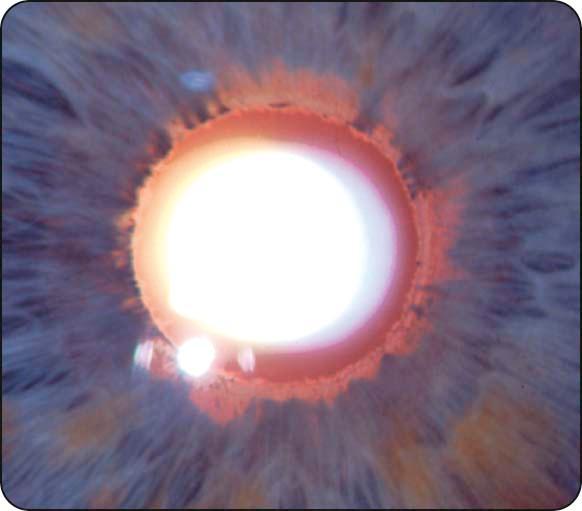
Anterior lens surface: central disc and peripheral band of PXF, with a clear zone between ( Fig. 10.12 ); may be seen only with pupillary dilatation.
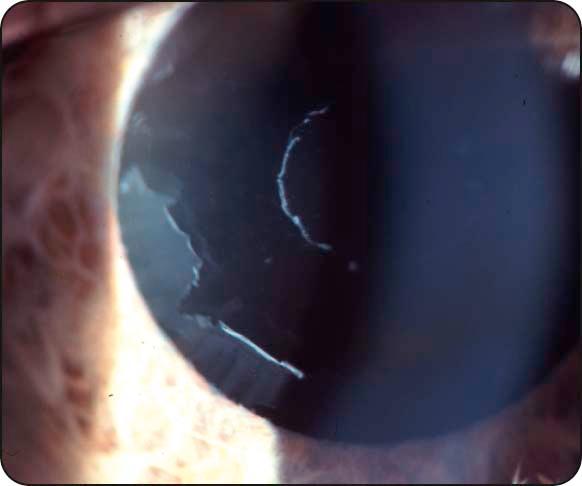
Gonioscopy: (a) trabecular hyperpigmentation and a band running on or anterior to the Schwalbe line (Sampaolesi line; Fig. 10.13 ); (b) dandruff-like PXF particles may be seen; there is an increased risk of angle closure, probably due to zonular laxity.
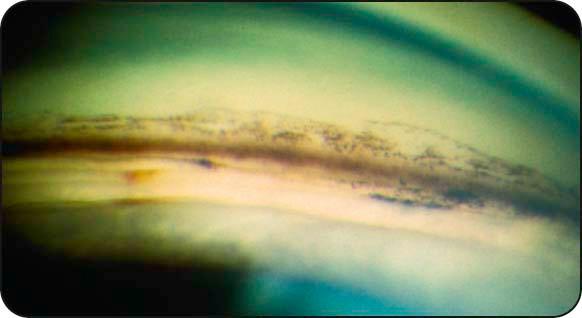
Treatment: observation at 6-monthly intervals to detect elevation of IOP.
Pathogenesis: trabecular obstruction and damage by PXF material and pigment. The cumulative risk of glaucoma in eyes with PXF is approximately 5% at 5 years and 15% at 10 years. A patient with unilateral pseudoexfoliation glaucoma and only PXF in the fellow eye has a 50% 5-year risk of glaucoma in the fellow eye, but only a low risk if there is no PXF.
Diagnosis
Presentation: in 7th decade with chronic unilateral elevation of IOP; an acute elevation occasionally occurs due to angle closure or even with a wide-open angle.
Signs: PXF and glaucomatous optic neuropathy.
Prognosis: worse than in POAG because the IOP is often significantly elevated and may also exhibit great fluctuation; severe damage may therefore develop relatively rapidly.
Treatment
Medical: same as for POAG but with a greater likelihood of requiring laser or surgery.
Laser trabeculoplasty: effective, particularly in the medium term.
Surgery: same success rate as in POAG.
Trabecular aspiration: confers at least a short-term benefit, and can be performed at the same time as cataract surgery or trabeculectomy.
Pathogenesis: liberation of pigment granules from the iris pigment epithelium due to ‘reverse pupil block,’ with resultant posterior bowing of the iris and iridozonular touch. Pigment is deposited throughout the anterior segment. The condition primarily affects whites and may be inherited as AD with variable penetrance; myopia is present in the majority.
Diagnosis
Presentation: typically asymptomatic, although corneal oedema with blurring and haloes may occur in response to IOP spikes; in some patients, this may be precipitated by exercise.
Cornea: pigment deposition on the endothelium in a vertical spindle-shaped distribution (Krukenberg spindle; Fig. 10.14 ).
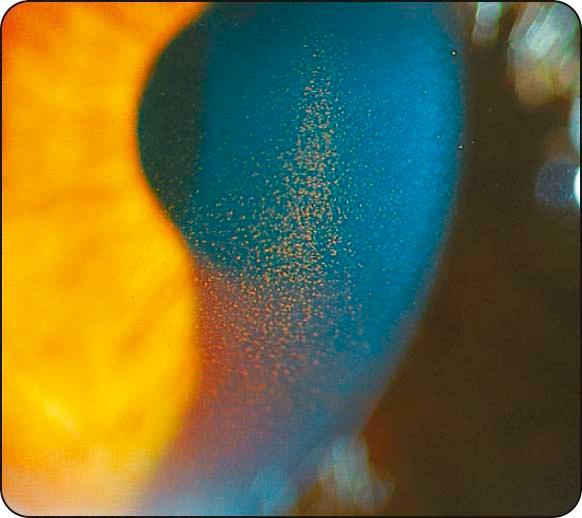
Anterior chamber: usually very deep.
Iris: radial slit-like transillumination defects ( Fig. 10.15 ) and fine surface pigment granules.
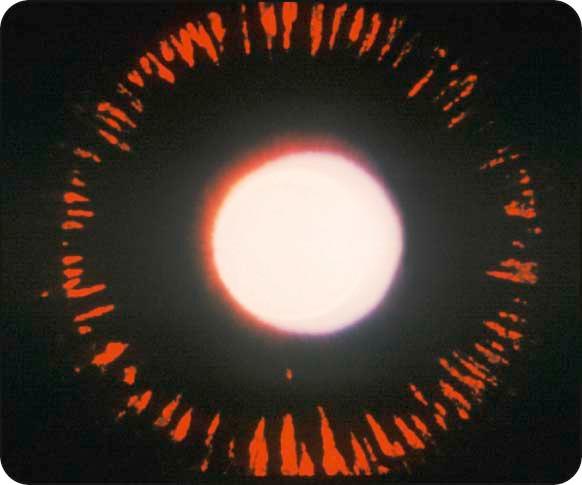
Gonioscopy: very wide angle with mid-peripheral iris concavity and homogeneous trabecular hyperpigmentation ( Fig. 10.16 ); pigment may also be seen on or anterior to Schwalbe line.
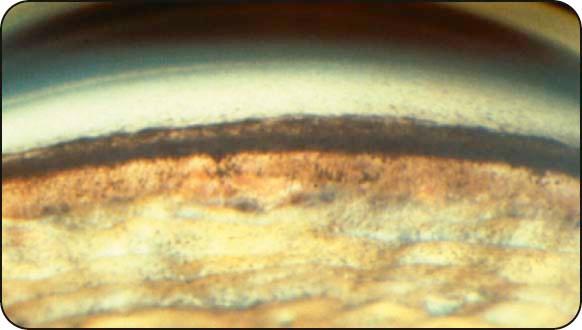
Treatment: observation at 6- to 12-monthly intervals to detect elevation of IOP.
Pathogenesis: approximately one-third of patients with pigment dispersion syndrome (PDS) develop OHT or chronic open-angle glaucoma after 15 years. Elevation of IOP appears to be caused by both pigmentary obstruction of the intertrabecular spaces and secondary damage to the trabeculum; men are affected twice as frequently as women.
Diagnosis
Presentation: in 3rd and 4th decades, usually with chronic glaucoma.
Signs: those of PDS, together with glaucomatous optic neuropathy; IOP may be unstable and asymmetric disease is common.
Differential diagnosis: (a) POAG with a heavily pigmented trabeculum, (b) pseudoexfoliation, (c) pseudophakic pigmentary glaucoma, (d) sequelae to uveitis, and (e) subacute angle-closure glaucoma.
Treatment
Medical: similar to that of POAG; miotics are theoretically of particular benefit but carry disadvantages (e.g. risk of retinal detachment) outweighing the benefits in most cases.
Laser trabeculoplasty: often initially effective.
Trabeculectomy: more commonly performed than in POAG, although results are variable.
Pathogenesis: iris neovascularization (rubeosis iridis) occurs under the influence of growth factors produced in response to severe retinal ischaemia. Angle involvement initially impairs aqueous outflow in the presence of an open angle and later contracts resulting in angle closure.
Causes: (a) ischaemic central retinal vein occlusion (most common), (b) diabetes, (c) arterial retinal vascular disease (central retinal artery occlusion, ocular ischaemic syndrome), (d) intraocular tumours, (e) long-standing retinal detachment, and (f) chronic intraocular inflammation.
Classification: (a) rubeosis iridis, (b) secondary open-angle glaucoma, and (c) secondary synechial angle-closure glaucoma.
Diagnosis
Tiny dilated capillary tufts or red spots at the pupillary margin; new vessels grow radially over the surface of the iris toward the angle ( Fig. 10.17 ).
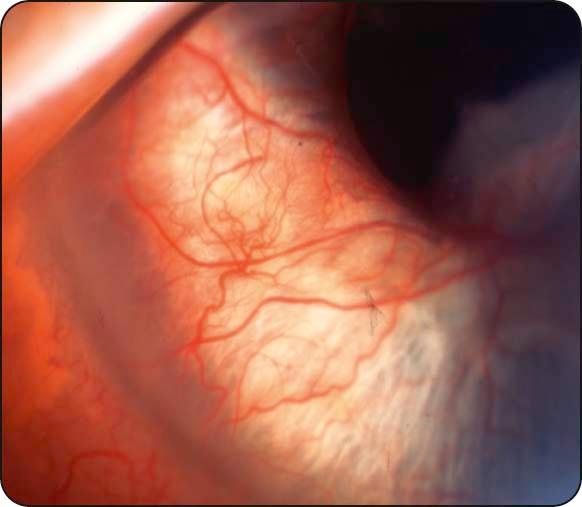
Angle neovascularization in the absence of pupillary involvement may occur, so gonioscopy without mydriasis should be performed in eyes at high risk.
Treatment
Early panretinal photocoagulation (PRP).
Intravitreal anti-VEGF agents (e.g. bevacizumab) may decrease neovascularization and improve IOP control.
Treatment of underlying cause (e.g. retinal detachment), if possible.
Diagnosis: neovascular tissue proliferation across the face of the angle.
Treatment
Medical: (a) as for POAG (avoiding miotics and prostaglandin derivatives), (b) topical apraclonidine and/or oral acetazolamide as temporizing measures, (c) topical atropine 1% and steroids if significant inflammation is present, and (d) intravitreal anti-VEGF agents may be effective if fibrovascular angle closure has not supervened.
PRP: indirect ophthalmoscopic application and/or mechanical pupillary dilatation (exceptionally) may be required.
Cyclodiode: considered if medical IOP control is not possible, particularly if the eye is painful, has useful visual potential, or corneal oedema precludes PRP.
Diagnosis
As rubeosis progresses, contraction of fibrovascular tissue occludes the angle ( Fig. 10.18 ).
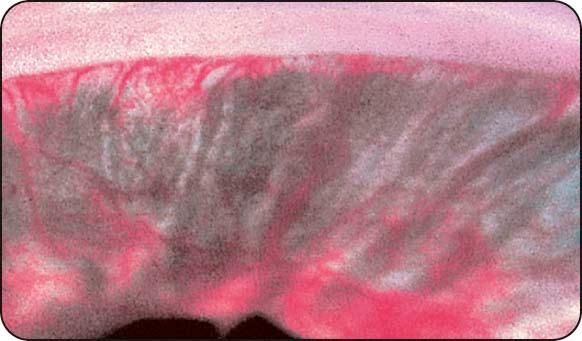
IOP can be very high, with globe congestion and pain.
Severe visual impairment is typical, due to the glaucoma or to the underlying cause.
Prognosis is poor unless the neovascular process can be arrested.
Treatment
Medical: as above; steroids and atropine alone may be adequate if there is no potential for vision; intravitreal anti-VEGF agents will not reverse established angle closure.
Retinal ablation: (a) PRP if the fundus can be adequately visualized, or (b) trans-scleral cryotherapy or diode laser for eyes with opaque media.
Surgery: (a) cyclodiode, (b) endocyclodiode, or (c) drainage surgery (enhanced trabeculectomy or shunt) to control IOP, particularly in eyes with visual potential.
Other: retrobulbar alcohol injection or enucleation for intractable pain.
Pathogenesis: (a) formation of 360° posterior synechiae (seclusio pupillae) obstructs aqueous flow from the posterior to the anterior chamber, (b) anterior bowing of the iris (iris bombé), occurs and (c) iris becomes apposed to the trabeculum and PAS develop.
Diagnosis
Signs: (a) seclusio pupillae, (b) iris bombé ( Fig. 10.19 ), (c) shallow anterior chamber, and (d) signs of the underlying inflammatory condition.
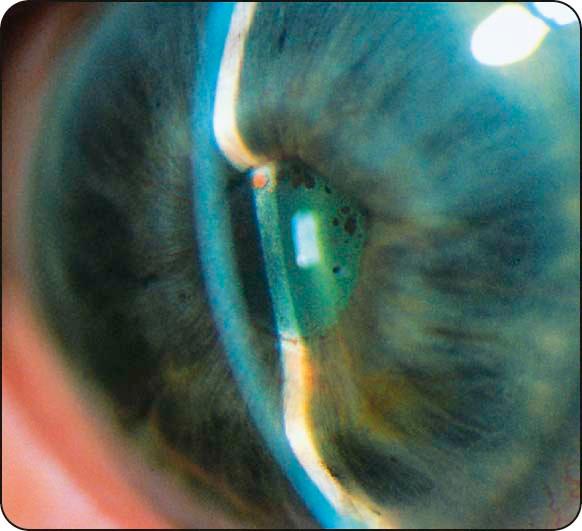
Gonioscopy: iridotrabecular contact; indentation may be used to assess the extent of PAS.
Pathogenesis: (a) inflammatory cells and debris accumulate in the angle, (b) subsequent organization and contraction of debris pulls the peripheral iris over the trabeculum, and (c) extensive PAS develop ( Fig. 10.20 ) but the anterior chamber remains deep.
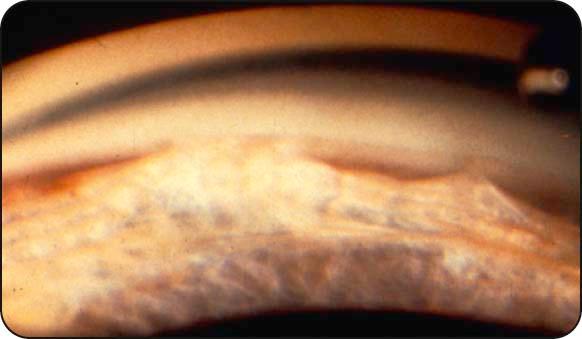
Become a Clinical Tree membership for Full access and enjoy Unlimited articles
If you are a member. Log in here